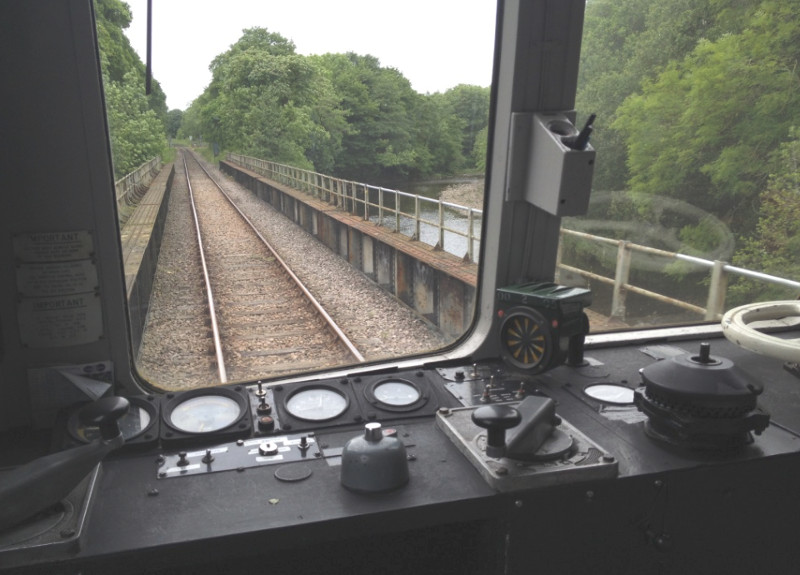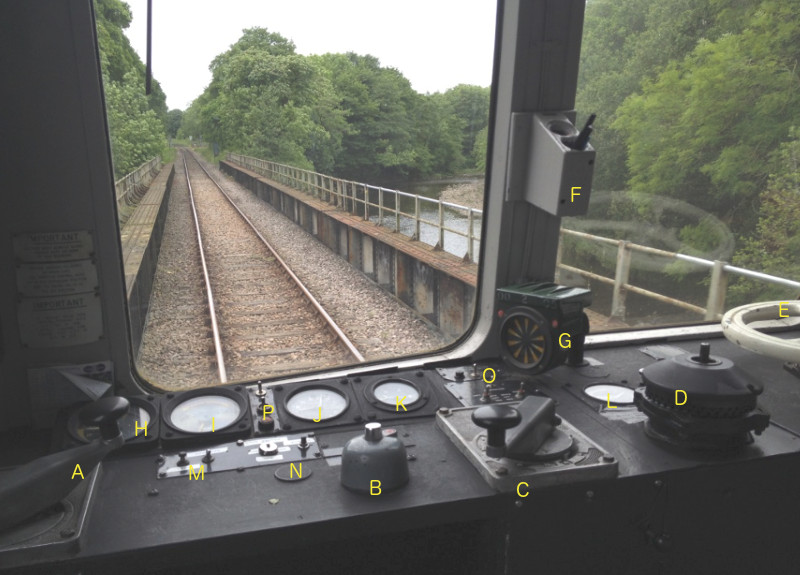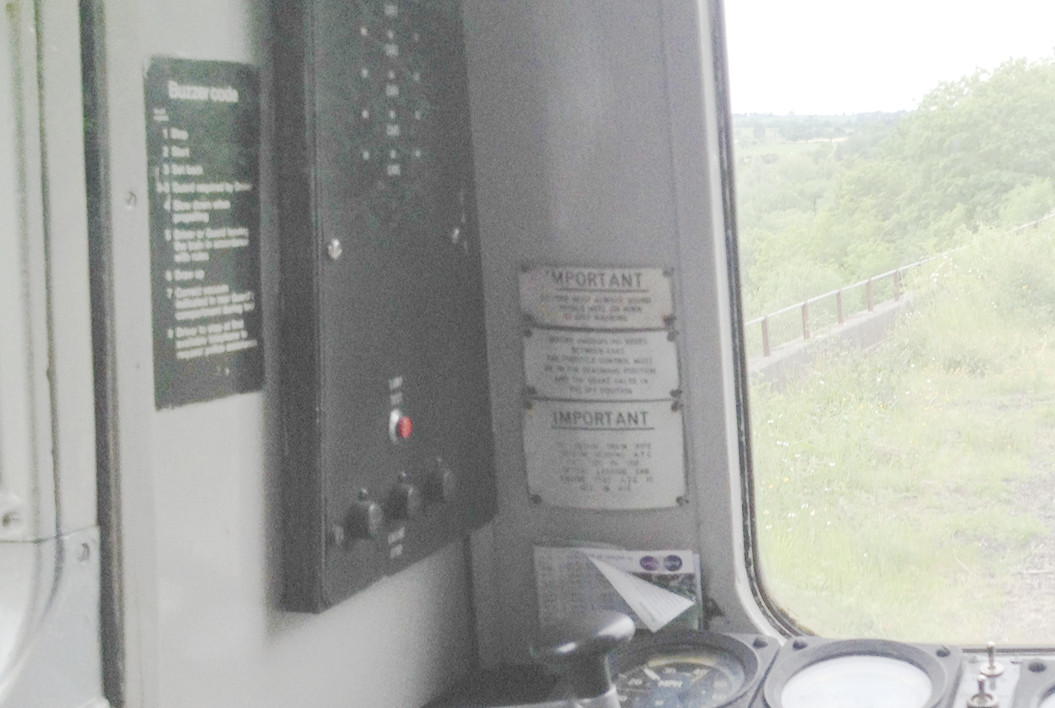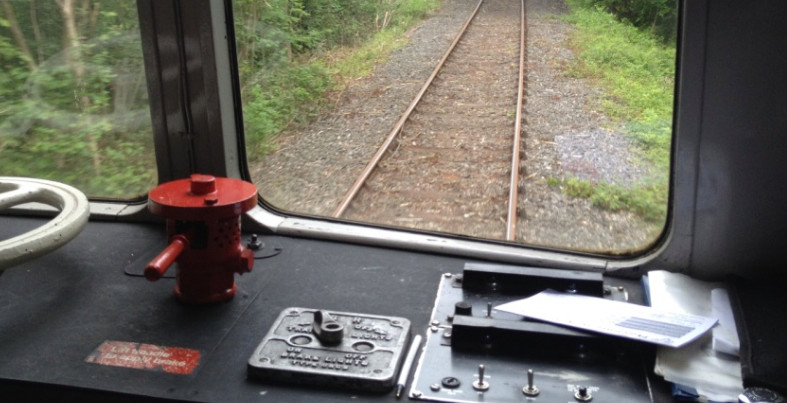|
grahame
|
 |
« on: April 10, 2020, 04:12:43 » |
|
This brings back memories though the picture is only 9 months old. It's the cab of a bubble car - though the layout looks just the same to me as other first generation units. Anyone car to describe what each of the controls and displays does?  |
|
|
|
|
 Logged
Logged
|
Coffee Shop Admin, Acting Chair of Melksham Rail User Group, Option 24/7 Melksham Rep
|
|
|
|
martyjon
|
 |
« Reply #1 on: April 10, 2020, 08:45:41 » |
|
This brings back memories though the picture is only 9 months old. It's the cab of a bubble car - though the layout looks just the same to me as other first generation units. Anyone car to describe what each of the controls and displays does?  Left side handle power control (Accelerator) Blob with the button cancel AWS▸ Next gear selector Far right brake control handle in fixture on windscreen Large dial speed Middle dial vaccum brake and reserve |
|
|
|
|
 Logged
Logged
|
|
|
|
|
Western Pathfinder
|
 |
« Reply #2 on: April 10, 2020, 08:52:27 » |
|
At the base of the windscreen central pillar,is the AWS▸ Sunflower indicator, in front of that to the slight right is a round black object ,which is the train brake control,missing its operating Handel.
Which would lead me to think that the unit is being driven from the other Cab.
|
|
|
|
|
 Logged
Logged
|
|
|
|
|
bobm
|
 |
« Reply #3 on: April 10, 2020, 08:56:18 » |
|
You mean Graham wasn't driving at the time? And I suppose the white circular thing at the edge of the shot is the steering wheel   |
|
|
|
|
 Logged
Logged
|
|
|
|
|
martyjon
|
 |
« Reply #4 on: April 10, 2020, 09:27:23 » |
|
This brings back memories though the picture is only 9 months old. It's the cab of a bubble car - though the layout looks just the same to me as other first generation units. Anyone car to describe what each of the controls and displays does?  Left side handle power control (Accelerator) Blob with the button cancel AWS▸ Next gear selector Far right brake control handle in fixture on windscreen Large dial speed Middle dial vaccum brake and reserve Having looked more closely the 2 large dials are as I said speed and engine revs Key equivalent to ignition key Switches front lights, cab lights, 1st gen DMUs▸ had oil tail lights responsibility of the guard |
|
|
|
|
 Logged
Logged
|
|
|
|
|
rogerw
|
 |
« Reply #5 on: April 10, 2020, 09:32:48 » |
|
The big white wheel is the handbrake
|
|
|
|
|
 Logged
Logged
|
I like to travel. It lets me feel I'm getting somewhere.
|
|
|
|
martyjon
|
 |
« Reply #6 on: April 10, 2020, 09:40:46 » |
|
This brings back memories though the picture is only 9 months old. It's the cab of a bubble car - though the layout looks just the same to me as other first generation units. Anyone car to describe what each of the controls and displays does?  Left side handle power control (Accelerator) Blob with the button cancel AWS▸ Next gear selector Far right brake control handle in fixture on windscreen Large dial speed Middle dial vaccum brake and reserve Having looked more closely the 2 large dials are as I said speed and engine revs Key equivalent to ignition key Switches front lights, cab lights, 1st gen DMUs▸ had oil tail lights responsibility of the guard Somewhere there is a press button to acknowledge the guards instructions Can't remember what 4th dial was Starter button on left side not shown on piccy which started all engines on unit together. Individual engines were started alongside the unit from ground level No fuel gauge in cab all tanks had a gauge on the tanks themselves |
|
|
|
|
 Logged
Logged
|
|
|
|
|
martyjon
|
 |
« Reply #7 on: April 10, 2020, 09:49:10 » |
|
Oh I forgot there is a switch for the windscreen wipers which also had a variable speed control and that reminds me that the 4th dial was the air pressure dial for the cars engine needed to operate the windscreen wipers
|
|
|
|
|
 Logged
Logged
|
|
|
|
|
martyjon
|
 |
« Reply #8 on: April 10, 2020, 09:57:04 » |
|
Finally for my two pennyworth there is a toggle switch for the two tone air horn
Have I missed anything ?
|
|
|
|
|
 Logged
Logged
|
|
|
|
|
Witham Bobby
|
 |
« Reply #9 on: April 10, 2020, 09:57:56 » |
|
What you cant see, to the left, is the stack of blue lights. There were three vertical columns of lights. The columns to left and right indicated, when lit, that the engine it reported was running. The central column of lights indicated that the final drive was engaged correctly. In a single car DMU▸ , only the top three lights across the stack would be relevant. A 3-car, with two cars powered, would show the top two rows. There was a limit (six power cars??) on how long a DMU train could be. I don't know if this related to the number of lights, or whether some technical limit decided the length of the train and this in turn affected how many lights there were.
|
|
|
|
|
 Logged
Logged
|
|
|
|
|
grahame
|
 |
« Reply #10 on: April 10, 2020, 09:58:44 » |
|
Many useful bits of information and reminders there. Looking to correlate that ...  A Accelerator B AWS▸ Cancel button C Gear Change D Vacuum Brake E Manual Brake F Rack for gear brake handle and gear level handle G AWS - most recent status indicator H Speed indication I Engine Revs J Vacuum pressure K Air pressure L ? Now ... a little lost as to which switches are which ... M N O P |
|
|
|
|
 Logged
Logged
|
Coffee Shop Admin, Acting Chair of Melksham Rail User Group, Option 24/7 Melksham Rep
|
|
|
|
martyjon
|
 |
« Reply #11 on: April 10, 2020, 10:28:40 » |
|
I think the red button (P) is engines stop
|
|
|
|
|
 Logged
Logged
|
|
|
|
|
grahame
|
 |
« Reply #12 on: April 10, 2020, 10:35:21 » |
|
I think the red button (P) is engines stop
Yes - that makes sense. There are two switches just above "P" (part of the "P" group). Lots of switches mentioned - which were those? |
|
|
|
|
 Logged
Logged
|
Coffee Shop Admin, Acting Chair of Melksham Rail User Group, Option 24/7 Melksham Rep
|
|
|
|
grahame
|
 |
« Reply #13 on: April 10, 2020, 10:48:51 » |
|
What you cant see, to the left, is the stack of blue lights. There were three vertical columns of lights. The columns to left and right indicated, when lit, that the engine it reported was running. The central column of lights indicated that the final drive was engaged correctly. In a single car DMU▸ , only the top three lights across the stack would be relevant. A 3-car, with two cars powered, would show the top two rows. There was a limit (six power cars??) on how long a DMU train could be. I don't know if this related to the number of lights, or whether some technical limit decided the length of the train and this in turn affected how many lights there were.
I've looked through my pictures and found an image that went a bit off to the left - please excuse the awful quality as I've had to play with the colour profile to get it to show at all. Also the rest of the control panel - the bit the driver can't reach from the driving seat.   |
|
|
|
|
 Logged
Logged
|
Coffee Shop Admin, Acting Chair of Melksham Rail User Group, Option 24/7 Melksham Rep
|
|
|
|
Electric train
|
 |
« Reply #14 on: April 10, 2020, 11:32:15 » |
|
What you cant see, to the left, is the stack of blue lights. There were three vertical columns of lights. The columns to left and right indicated, when lit, that the engine it reported was running. The central column of lights indicated that the final drive was engaged correctly. In a single car DMU▸ , only the top three lights across the stack would be relevant. A 3-car, with two cars powered, would show the top two rows. There was a limit (six power cars??) on how long a DMU train could be. I don't know if this related to the number of lights, or whether some technical limit decided the length of the train and this in turn affected how many lights there were.
I've looked through my pictures and found an image that went a bit off to the left - please excuse the awful quality as I've had to play with the colour profile to get it to show at all. Also the rest of the control panel - the bit the driver can't reach from the driving seat.   Top photo are the engine and control air indication lamps 3 per power car outer ones are engine run The lower buttons outer ones are engine start the centre (black) i think was the lamp test. Fault finding this was a challenge given to us apprentices at Reading DMU Second photo Red device the emergency vacuum brake the single silver control is the car and train light control, buttons for car lights only centre leaver train lights Next are the Smiths Heater control for this car, each car had its own set. Smiths heaters used diesel fuel for combustion and were very effective at filling the car with smoke  |
|
|
|
|
 Logged
Logged
|
Starship just experienced what we call a rapid unscheduled disassembly, or a RUD, during ascent,”
|
|
|
|


